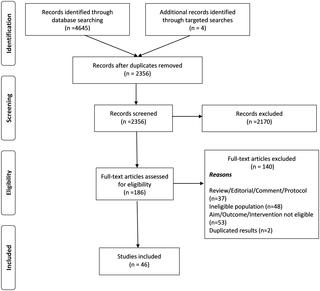Our official English website, www.x-mol.net, welcomes your
feedback! (Note: you will need to create a separate account there.)
Opioid-related treatment, interventions, and outcomes among incarcerated persons: A systematic review.
PLOS Medicine ( IF 10.5 ) Pub Date : 2019-12-31 , DOI: 10.1371/journal.pmed.1003002 Monica Malta 1, 2, 3 , Thepikaa Varatharajan 1 , Cayley Russell 1 , Michelle Pang 1 , Sarah Bonato 4 , Benedikt Fischer 5, 6, 7
PLOS Medicine ( IF 10.5 ) Pub Date : 2019-12-31 , DOI: 10.1371/journal.pmed.1003002 Monica Malta 1, 2, 3 , Thepikaa Varatharajan 1 , Cayley Russell 1 , Michelle Pang 1 , Sarah Bonato 4 , Benedikt Fischer 5, 6, 7
Affiliation

|
BACKGROUND
Worldwide opioid-related overdose has become a major public health crisis. People with opioid use disorder (OUD) are overrepresented in the criminal justice system and at higher risk for opioid-related mortality. However, correctional facilities frequently adopt an abstinence-only approach, seldom offering the gold standard opioid agonist treatment (OAT) to incarcerated persons with OUD. In an attempt to inform adequate management of OUD among incarcerated persons, we conducted a systematic review of opioid-related interventions delivered before, during, and after incarceration.
METHODS AND FINDINGS
We systematically reviewed 8 electronic databases for original, peer-reviewed literature published between January 2008 and October 2019. Our review included studies conducted among adult participants with OUD who were incarcerated or recently released into the community (≤90 days post-incarceration). The search identified 2,356 articles, 46 of which met the inclusion criteria based on assessments by 2 independent reviewers. Thirty studies were conducted in North America, 9 in Europe, and 7 in Asia/Oceania. The systematic review included 22 randomized control trials (RCTs), 3 non-randomized clinical trials, and 21 observational studies. Eight observational studies utilized administrative data and included large sample sizes (median of 10,419 [range 2273-131,472] participants), and 13 observational studies utilized primary data, with a median of 140 (range 27-960) participants. RCTs and non-randomized clinical trials included a median of 198 (range 15-1,557) and 44 (range 27-382) participants, respectively. Twelve studies included only men, 1 study included only women, and in the remaining 33 studies, the percentage of women was below 30%. The majority of study participants were middle-aged adults (36-55 years). Participants treated at a correctional facility with methadone maintenance treatment (MMT) or buprenorphine (BPN)/naloxone (NLX) had lower rates of illicit opioid use, had higher adherence to OUD treatment, were less likely to be re-incarcerated, and were more likely to be working 1 year post-incarceration. Participants who received MMT or BPN/NLX while incarcerated had fewer nonfatal overdoses and lower mortality. The main limitation of our systematic review is the high heterogeneity of studies (different designs, settings, populations, treatments, and outcomes), precluding a meta-analysis. Other study limitations include the insufficient data about incarcerated women with OUD, and the lack of information about incarcerated populations with OUD who are not included in published research.
CONCLUSIONS
In this carefully conducted systematic review, we found that correctional facilities should scale up OAT among incarcerated persons with OUD. The strategy is likely to decrease opioid-related overdose and mortality, reduce opioid use and other risky behaviors during and after incarceration, and improve retention in addiction treatment after prison release. Immediate OAT after prison release and additional preventive strategies such as the distribution of NLX kits to at-risk individuals upon release greatly decrease the occurrence of opioid-related overdose and mortality. In an effort to mitigate the impact of the opioid-related overdose crisis, it is crucial to scale up OAT and opioid-related overdose prevention strategies (e.g., NLX) within a continuum of treatment before, during, and after incarceration.
中文翻译:

阿片类药物相关的治疗,干预措施和被监禁者的结局:系统评价。
背景技术世界范围内与阿片样物质有关的药物过量已经成为主要的公共卫生危机。阿片类药物使用障碍(OUD)的人在刑事司法系统中人数过多,且与阿片类药物相关的死亡率较高。但是,教养所经常采用仅节欲的方法,很少为被监禁的OUD患者提供金标准的阿片样物质激动剂(OAT)。为了给被监禁者提供适当的OUD管理信息,我们对在监禁之前,之中和之后进行的与阿片类药物相关的干预措施进行了系统的回顾。方法和发现我们系统地审查了8个电子数据库,以收集2008年1月至2019年10月之间发表的经过同行评审的原始文献。我们的审查包括对有监禁或最近被释放到社区(被监禁后≤90天)的成年OUD参与者进行的研究。搜索确定了2356篇文章,其中2篇独立审阅者基于评估得出其中46篇符合纳入标准。在北美进行了30项研究,在欧洲进行了9项研究,在亚洲/大洋洲进行了7项研究。系统评价包括22项随机对照试验(RCT),3项非随机临床试验和21项观察性研究。八项观察性研究利用行政数据并包括大样本量(中位数为10,419 [范围2273-131,472]参与者),而13项观察性研究利用原始数据,中位值为140(范围为27-960)。RCT和非随机临床试验的中位数为198(范围15-1,557)和44(范围27-382)的参与者。十二项研究仅包含男性,一项研究仅包含女性,其余33项研究中,女性比例低于30%。大多数研究参与者是中年成年人(36-55岁)。在接受了美沙酮维持治疗(MMT)或丁丙诺啡(BPN)/纳洛酮(NLX)的教养所中接受治疗的参与者非法阿片类药物的使用率较低,对OUD治疗的依从性更高,被再次监禁的可能性较小,并且更多可能在监禁后一年内工作。参加MMT或BPN / NLX监禁的参与者非致命性用药过量较少,死亡率较低。我们系统评价的主要局限性在于研究的高度异质性(不同的设计,设置,人群,治疗和结果),排除荟萃分析。其他研究局限性包括有关被监禁的有OUD的妇女的数据不足,以及缺乏有关未纳入公开研究的有OUD的被监禁的人口的信息。结论在这项精心进行的系统评价中,我们发现惩教设施应扩大有OUD的被监禁者的OAT。该策略可能会减少与阿片类药物有关的药物过量和死亡率,减少在阿片类药物治疗期间和之后的阿片类药物使用和其他危险行为,并提高监狱释放后对成瘾治疗的保留率。监狱释放后立即进行OAT手术,并采取其他预防措施,例如在释放时向有风险的人分发NLX试剂盒,大大减少了与阿片类药物有关的药物过量和死亡率的发生。
更新日期:2020-01-14
中文翻译:

阿片类药物相关的治疗,干预措施和被监禁者的结局:系统评价。
背景技术世界范围内与阿片样物质有关的药物过量已经成为主要的公共卫生危机。阿片类药物使用障碍(OUD)的人在刑事司法系统中人数过多,且与阿片类药物相关的死亡率较高。但是,教养所经常采用仅节欲的方法,很少为被监禁的OUD患者提供金标准的阿片样物质激动剂(OAT)。为了给被监禁者提供适当的OUD管理信息,我们对在监禁之前,之中和之后进行的与阿片类药物相关的干预措施进行了系统的回顾。方法和发现我们系统地审查了8个电子数据库,以收集2008年1月至2019年10月之间发表的经过同行评审的原始文献。我们的审查包括对有监禁或最近被释放到社区(被监禁后≤90天)的成年OUD参与者进行的研究。搜索确定了2356篇文章,其中2篇独立审阅者基于评估得出其中46篇符合纳入标准。在北美进行了30项研究,在欧洲进行了9项研究,在亚洲/大洋洲进行了7项研究。系统评价包括22项随机对照试验(RCT),3项非随机临床试验和21项观察性研究。八项观察性研究利用行政数据并包括大样本量(中位数为10,419 [范围2273-131,472]参与者),而13项观察性研究利用原始数据,中位值为140(范围为27-960)。RCT和非随机临床试验的中位数为198(范围15-1,557)和44(范围27-382)的参与者。十二项研究仅包含男性,一项研究仅包含女性,其余33项研究中,女性比例低于30%。大多数研究参与者是中年成年人(36-55岁)。在接受了美沙酮维持治疗(MMT)或丁丙诺啡(BPN)/纳洛酮(NLX)的教养所中接受治疗的参与者非法阿片类药物的使用率较低,对OUD治疗的依从性更高,被再次监禁的可能性较小,并且更多可能在监禁后一年内工作。参加MMT或BPN / NLX监禁的参与者非致命性用药过量较少,死亡率较低。我们系统评价的主要局限性在于研究的高度异质性(不同的设计,设置,人群,治疗和结果),排除荟萃分析。其他研究局限性包括有关被监禁的有OUD的妇女的数据不足,以及缺乏有关未纳入公开研究的有OUD的被监禁的人口的信息。结论在这项精心进行的系统评价中,我们发现惩教设施应扩大有OUD的被监禁者的OAT。该策略可能会减少与阿片类药物有关的药物过量和死亡率,减少在阿片类药物治疗期间和之后的阿片类药物使用和其他危险行为,并提高监狱释放后对成瘾治疗的保留率。监狱释放后立即进行OAT手术,并采取其他预防措施,例如在释放时向有风险的人分发NLX试剂盒,大大减少了与阿片类药物有关的药物过量和死亡率的发生。











































 京公网安备 11010802027423号
京公网安备 11010802027423号